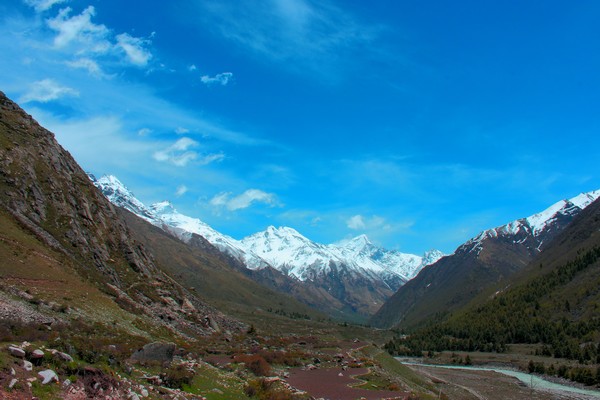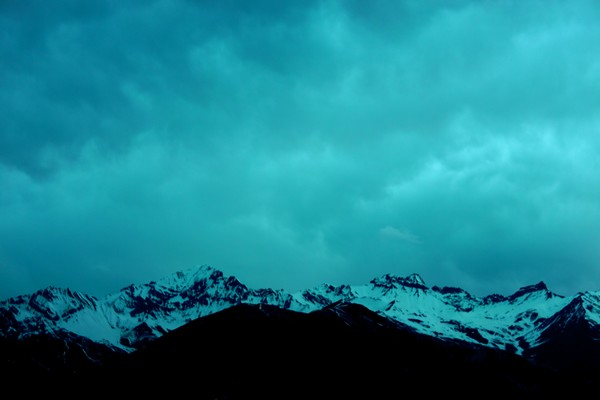Fasten your seat belt. I am now taking you to the uninhabited and never before seen regions of Himachal Pradesh, where you get a golden chance to be one with nature, amidst the silence of the Himalayas. Scroll down slowly, reading the descriptions of the photographs and the techniques I have used to obtain these shots. And do give your feedback at the end of your journey! Please find the Comments section at the bottom.
CHITKUL LANDSCAPE: THE LAST VILLAGE OF INDIA
The photograph above shows the Chitkul village landscape. Chitkul is a small village in the Kinnaur region of Himachal Pradesh, and it is called 'The last village of India', as just a few kilometers walk into the village leads one to the Indo-Tibet border. Chitkul is a picturesque village, a photographer's paradise. It is also the highest village in the valley. Seen in this picture is the Great Himalayan range in the background, and the Baspa river flowing through the landscape of Chitkul.
IMAGE DATA
Aperture: f/22
Shutter Speed: 1/60s
ISO speed: 100
Focal length: 28.8 mm (35mm equivalent)
Camera: Canon EOS 500D (hand held)
Lens: Canon EF-S 18-55mm IS lens
Location: Chitkul village, Kinnaur district, Himachal Pradesh
THE HIMALAYAS DIAGONALLY
Another shot from village Chitkul (see the first photograph and its description), with a view of the snow capped Himalayas, the abode of the Gods. I "discovered" this style of documenting the Himalayas diagonally on this trip to Himachal, and thereafter I was so fascinated by this (let me call it "diagonal landscaping") technique that I always photograph any landscape from the diagonal perspective after photographing it in the usual horizontal horizon way.
IMAGE DATA
Aperture: f/22
Shutter Speed: 1/100s
ISO speed: 100
Focal length: 88 mm (35mm equivalent)
Camera: Canon EOS 500D (hand held)
Lens: Canon EF-S 18-55mm IS lens
Location: Chitkul village, Kinnaur district, Himachal Pradesh
GOD'S CANVAS
This photograph is actually a snap of God's own canvas. Yes, really! Look at the lovely textures on the mountain slopes. They are sure to captivate your attention. These are again "sketched" (naturally, of course) on the sedimentary rock ranges.
A small tributary of the Spiti river flows in the foreground.
IMAGE DATA
Aperture: f/5.6
Shutter Speed: 1/400s
ISO speed: 100
Focal length: 88 mm (35mm equivalent)
Camera: Canon EOS 500D (hand held)
Lens: Canon EF-S 18-55mm IS lens
Location: Spiti, Himachal Pradesh
THE UNSEEN HIMALAYAN LANDSCAPE
This is one of my favourite photographs. When you look at it, you would want to look at the mountains in the foreground again and again. Their colour, their texture, their grandeur, their spleandour, everything about them can be seen here. At the bottom can be seen the narrow road that passes by them. I photographed this unseen landscape from a moving vehicle, and hence had to use a relatively larger aperture to avoid motion blur from the bumps on the way, since I was already motionless, thanks to the beauty of the Himalayas.
IMAGE DATA
Aperture: f/11
Shutter Speed: 1/125s
ISO speed: 100
Focal length: 28.8 mm (35mm equivalent)
Camera: Canon EOS 500D (hand held)
Lens: Canon EF-S 18-55mm IS lens
Location: Spiti, Himachal Pradesh
ICING ON THE BROWN RANGE
First look at the brown mountain range in the foreground. Note the particularly rich texture of the range; the lovely shades of brown too. Then there's even an icing on this "brown cake"-- the range just behind it is entirely snow covered!
IMAGE DATA
Aperture: f/5.6
Shutter Speed: 1s
ISO speed: 100
Focal length: 88 mm (35mm equivalent)
Camera: Canon EOS 500D (hand held: yes, I managed it even at 1s exposure,
thanks to IS)
Lens: Canon EF-S 18-55mm IS lens
Location: Spiti, Himachal Pradesh
WHEN THE SUN SETS.....
When the sun sets in the Himalayas, a completely new world springs up. Darkness descends all over, but the snow peaks reflect the cool moonlight, which even through the viewfinder, makes you shiver, really. The sky takes over blue hues, a feast to the eyes. The valleys become dark, with a few tungsten lights here and there from human inhabited areas, which are anyway sparsely populated (some with as little as 20 people!). Do not forget to carry your tripod; its absolutely necessary for these low light shots.
Aperture: f/5.6
Shutter Speed: 0.6s
ISO speed: 100
Focal length: 88 mm (35mm equivalent)
Camera: Canon EOS 500D (on a tripod)
Lens: Canon EF-S 18-55mm IS lens
Location: Spiti, Himachal Pradesh
THE HIMALAYAN FORT
No, this is not a picture from Rajasthan, and the "wall" you see is not the guard wall on the periphery of some fort. This is a small range in Spiti, where the texture of the Himalayas assumes the form of an ancient fort wall. Look attentively at the texture; you'll really doubt if these are really natural! But yes, they are, they are indeed a natural wonder. And you would have noticed that this shot is another manifestation of my "diagonal landscaping" technique (see the second photograph of this page)
IMAGE DATA
Aperture: f/13
Shutter Speed: 1/80s
ISO speed: 100
Focal length: 88 mm (35mm equivalent)
Camera: Canon EOS 500D (hand held)
Lens: Canon EF-S 18-55mm IS lens
Location: Spiti, Himachal Pradesh
THE HIMALAYAN FORT: "NORMAL VIEW"
The same "Himalayan fort wall" as in the preceding photograph, but shot horizontally to reveal the Spiti river in the foreground.
IMAGE DATA
Aperture: f/13
Shutter Speed: 1/80s
ISO speed: 100
Focal length: 88 mm (35mm equivalent)
Camera: Canon EOS 500D (hand held)
Lens: Canon EF-S 18-55mm IS lens
Location: Spiti, Himachal Pradesh
SPITI: THE HIMALAYAN DESERT
Spiti valley is often called the 'cold desert'. And it is true to its name, as there's almost no rain annually, and except for the Spiti river flowing in the valley, there hardly appears to be any water source. Consequently, the land is barren, with no vegetation.
Note the rich texture of the sandy Himalayas here. I shot the above photograph from a moving vehicle; hence I took it at f/3.5, losing some depth of field. Such steps are essential to prevent blurs as you can't have the vehicle stopped at your will always: there's a single narrow road, and vehicles can suddenly come from behind, unseen on account of the wavy mountain roads, raising the danger of accidents.
IMAGE DATA
Aperture: f/3.5
Shutter Speed: 1/1600s
ISO speed: 100
Focal length: 28.8 mm (35mm equivalent)
Camera: Canon EOS 500D (hand held)
Lens: Canon EF-S 18-55mm IS lens
Location: Spiti, Himachal Pradesh
THE ANCIENT SEABED
This photograph depicts the ancient character of the Himalayas, in that they were formed when the Indo-Australian tectonic plate collided with the Eurasian plate some 45 million years ago. The seabed was thrust upwards, resulting in these sedimentary rock formations which along with the metamorphic rocks, constitute the Himalayas. This area of the Himalayas, close to the Pin Valley in Spiti, is exceptionally rich in fossils, owing to the presence of the sedimentary rocks.
Aperture: f/5.6
Shutter Speed: 1/320s
ISO speed: 100
Focal length: 32 mm (35mm equivalent)
Camera: Canon EOS 500D (hand held)
Lens: Canon EF-S 18-55mm IS lens
Location: Spiti, Himachal Pradesh
THE FINAL DESTINATION
While in Spiti, a visit to the Kunzum Pass from Kaza (the Pass is at a height of 4550 metres or 14,924 feet) is a must. The road offers breathtaking views of the Himalayas. The photograph shows a Buddhist Stupa near the Kunzum pass. We had the chance to revel in the joy of being one with the Himalayas, the abode of Lord Shiva Himself. The view really does transport one to the abode of the Almighty, which is, our final destination.
IMAGE DATA
Aperture: f/4.5
Shutter Speed: 1/2000s
ISO speed: 100
Focal length: 28.8 mm (35mm equivalent)
Camera: Canon EOS 500D (hand held)
Lens: Canon EF-S 18-55mm IS lens
Location: Near Kunzum Pass, Spiti, Himachal Pradesh
PICTURE PERFECT HIMALAYAS
When you visit the Himalayas, you'll realise how picture perfect they are. An example can be seen above, shot on the route from Kaza to the Kunzum Pass. In the background is the magnificent range, and in the foreground, the lovely blue green waters of the Spiti river. The blue sky and the clouds add to the drama.
IMAGE DATA
Aperture: f/20
Shutter Speed: 1/100s
ISO speed: 100
Focal length: 28.8 mm (35mm equivalent)
Camera: Canon EOS 500D (hand held)
Lens: Canon EF-S 18-55mm IS lens
Location: Near Kunzum Pass, Spiti, Himachal Pradesh












awsum yaar.... u r really growing into a professional!!
ReplyDelete@Yash: Thanks friend! Do keep visiting for more photographs of the Himalayas coming soon, and also view the 'HIMALAYAN WILDLIFE' page from the tab on the homepage.
ReplyDeleteThanks again!
I am spell bound by your pictures....just awesome and I don't have many words to express...
ReplyDeleteBest of luck.
@Urmimala: Thank you for your appreciation.....I really get a lot of encouragement by the viewer's comments. Thank you again and do keep visiting the blog for more photos coming up in 'HIMALAYAN WILDLIFE' section and more!
ReplyDeleteThanks again for your comment!
Hello Devaang, your pictures are amazing. I have been to many of these areas and I know it is out of this world experience. Can I borrow your pictures my friend ??
ReplyDeleteNavjit Singh Aulakh
@Navjit: Thank you for your appreciation. Navjit, if you require the original high resolution prints, or have other queries, please contact me personally on:
ReplyDeletedivinedevaangjain@yahoo.in
really awesome scenery, i am travelling to the Himalayas next year and as a beginner photographer it is great you have listed the camera settings in each pic- for learning purposes!
ReplyDeleteHi viewer,
DeleteThank you for your appreciation; really glad you liked my work. You might also like to view my short films and TV travel shows filmed in the Himalayas' most exotic and unexplored locations-
Here is one such film: http://www.youtube.com/watch?v=DMsstTHbPt8
More films on the Himalayas can be found on my website: www.sukhnidhey.com
And my YouTube Channel: www.youtube.com/SukhnidheyFilms
The Himalayas truly are divine; a place so otherworldly you'll be dazzled by the snow covered peaks and forget everything else. Yes, the camera settings would help you learn the technique, but another thing of major importance is to remember to be alert at all times. The Himalayas can throw a stunning view at you at any time, when you least expect.
All the best for your trip- wish you a life changing trip full of excellent shooting opportunities. Also remember the saying- "Leave nothing but your footprint". Remember, as photographers we have the responsibility to protect the environment and not interfere in natural processes in any way.
Do keep visiting, and sharing the love for nature. Hope to see you around more often. Thanks again, and wish you all the best.